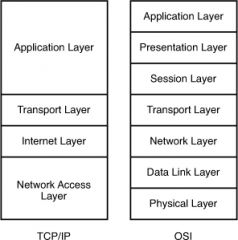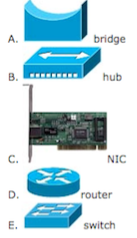![]()
![]()
![]()
Use LEFT and RIGHT arrow keys to navigate between flashcards;
Use UP and DOWN arrow keys to flip the card;
H to show hint;
A reads text to speech;
7 Cards in this Set
- Front
- Back
|
Question 1
Which OSI layer header contains the address of a destination host that is on another network? A. application B. session C. transport D. network E. data link F. physical |
Answer: D
|
|
|
At which layer of the OSI model does the protocol that provides the information that is displayed by the show cdp neighborscommand operate?
A. application B. transport C. network D. physical E. data link |
Answer: E
Explanation CDP runs at Layer 2 (Data Link) of the OSI model -> E is correct. |
|
|
What are two common TCP applications? (Choose two)
A. TFTP B. SMTP C. SNMP D. FTP E. DNS |
Answer: B D
Explanation SMTP stands for Simple Mail Transfer Protocol. It’s a set of communication guidelines that allow software to transmit email over the Internet while File Transfer Protocol (FTP) is a standard network protocol used to transfer files from one host to another host over TCP-based network.Note: Simple Network Management Protocol (SNMP) uses UDP as the transport protocol for passing data between managers and agents. SNMP uses UDP to help reduce the impact on your network’s performance. Although SNMP can be configured to run on TCP but we should only do it in special situations. SNMP uses the UDP port 161 for sending and receiving requests, and port 162 for receiving traps from managed devices.DNS work on both the TCP and UDP protocols. DNS uses TCP for zone exchanges between servers and UDP when a client is trying to resolve a hostname to an IP address. Therefore in most cases we say “DNS uses UDP”. |
|
|
Which two characteristics describe the access layer of the hierarchical network design model? (Choose two)
A. layer 3 support B. port security C. redundant components D. VLANs E. PoE |
Answer: B D
Explanation The primary function of an access-layer is to provide network access to the end user.The hardware and software attributes of the access layer that support high availability include security services for additional security against unauthorized access to the network through the use of tools such as 802.1x, port security, DHCP snooping, Dynamic ARP Inspection, and IP Source Guard. |
|
|
Which layer of the TCP/IP stack combines the OSI model physical and data link layers?
A. Internet layer B. transport layer C. application layer D. network access layer |

Answer: D
Explanation The picture below compares the two TCP/IP and OSI models: |
|
|
Which layer of the OSI model controls the reliability of communications between network devices using flow control, sequencing and acknowledgments?
A. Physical B. Data-link C. Transport D. Network |
Answer: C
ExplanationTransmission Control Protocol (TCP) has all the features mentioned above and TCP resides in Transport Layer (Layer 4) of the OSI model. Flow control: A methodology used to ensure that receiving units are not overwhelmed with data from sending devices when buffers at a receiving unit are full, a message is transmitted to the sending unit to temporarily halt trans-missions until all the data in the receiving buffer has been processed and the buffer is again ready for action. Sequencing: is used to number segments before sending so they can be put back together again in the correct order at the receiving side. Acknowledgment: When the receiver gets the data, it sends a response telling the sender that the data have been safely arrived. |
|

Which network device functions only at Layer 1 of the OSI model?
|
Answer: B
Explanation In CCNA, the popular devices operate in Layer 1 are hub and repeater. |

